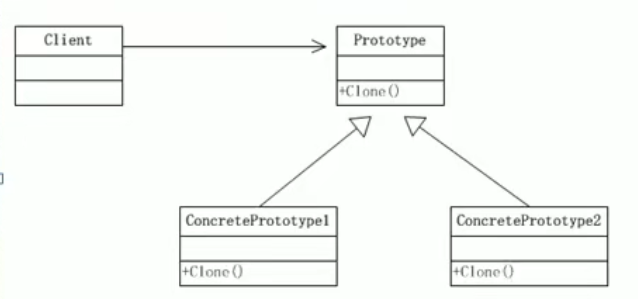设计模式之原型模式
原型模式解决克隆羊问题
有一只羊 姓名为:tom,年龄为:1,颜色为:白色,请编写程序创建和tom属性完全相同的十只羊

Prototype:原型类,声明一个克隆自己的接口
ConcretePrototype:具体的原型类,实现一个克隆自己的操作
Client:让一个原型对象克隆自己,从而创建一个新的对象(属性一样)
代码实现:
package com.cedric.prototype;
public class Sheep implements Cloneable{
private String name;
private int age;
private String color;
public Sheep(){
}
public Sheep(String name,int age,String color){
this.name = name;
this.age = age;
this.color = color;
}
public String getName() {
return name;
}
public void setName(String name) {
this.name = name;
}
public int getAge() {
return age;
}
public void setAge(int age) {
this.age = age;
}
public String getColor() {
return color;
}
public void setColor(String color) {
this.color = color;
}
@Override
public String toString() {
return "Sheep{" +
"name='" + name + '\'' +
", age=" + age +
", color='" + color + '\'' +
'}';
}
// 克隆该实例,使用默认的clone方法来完成
@Override
protected Object clone(){
Sheep sheep = null;
try {
sheep = (Sheep)super.clone();
} catch (CloneNotSupportedException e) {
System.out.println(e.getMessage());
}
return sheep;
}
}
package com.cedric.prototype;
public class Client {
public static void main(String[] args) {
System.out.println("原型模式完成对象的创建");
Sheep sheep = new Sheep("tom",1,"白色");
Sheep sheep1 = (Sheep) sheep.clone();
Sheep sheep2 = (Sheep) sheep.clone();
Sheep sheep3 = (Sheep) sheep.clone();
Sheep sheep4 = (Sheep) sheep.clone();
Sheep sheep5 = (Sheep) sheep.clone();
System.out.println(sheep);
System.out.println(sheep1);
System.out.println(sheep2);
System.out.println(sheep3);
System.out.println(sheep4);
System.out.println(sheep5);
}
}
原型模式:用原型实例指定创建对象的种类,并且通过拷贝这些原型,创建新的对象
原型模式默认是浅拷贝
深拷贝
1.复制对象的所有基本数据类型的成员变量值 2.对象进行深拷贝要对整个对象(包括对象的引用类型)进行拷贝
重写clone方法实现深拷贝
package com.cedric.prototype.deepclone;
import java.io.Serializable;
public class DeepCloneableTarget implements Serializable,Cloneable{
private static final long serialVersionUID = 1L;
private String cloneName;
private String cloneClass;
public DeepCloneableTarget(String cloneName,String cloneClass){
this.cloneName = cloneName;
this.cloneClass = cloneClass;
}
public String getCloneName() {
return cloneName;
}
public void setCloneName(String cloneName) {
this.cloneName = cloneName;
}
public String getCloneClass() {
return cloneClass;
}
public void setCloneClass(String cloneClass) {
this.cloneClass = cloneClass;
}
// 因为该类的属性都是String,因此使用默认的clone完成即可
@Override
protected Object clone() throws CloneNotSupportedException {
return super.clone();
}
}
使用序列化实现深拷贝
package com.cedric.prototype.deepclone;
import java.io.*;
public class DeepProtoType implements Serializable,Cloneable{
public String name;
public DeepCloneableTarget deepCloneableTarget; // 引用
public DeepProtoType(){
}
// 深拷贝 - 方式1 使用clone方法
@Override
protected Object clone() throws CloneNotSupportedException {
Object deep = null;
// 这里完成对基本数据类型(属性)和String的克隆
deep = super.clone();
// 对引用类型的属性进行单独处理
DeepProtoType deepProtoType = (DeepProtoType) deep;
deepProtoType.deepCloneableTarget = (DeepCloneableTarget) deepCloneableTarget.clone();
return deepProtoType;
}
// 深拷贝 - 方式2 通过对象的序列化实现
public DeepProtoType deepClone(){
// 创建流对象
ByteArrayOutputStream bos = null;
ObjectOutputStream oos = null;
ByteArrayInputStream bis = null;
ObjectInputStream ois = null;
try {
// 序列化
bos = new ByteArrayOutputStream();
oos = new ObjectOutputStream(bos);
oos.writeObject(this); //当前这个对象以对象流方式输出
// 反序列化
bis = new ByteArrayInputStream(bos.toByteArray());
ois = new ObjectInputStream(bis);
DeepProtoType copyObj = (DeepProtoType) ois.readObject();
return copyObj;
} catch (Exception e) {
e.printStackTrace();
return null;
} finally {
// 关闭流
try{
if(bos != null){
bos.close();
}
} catch (Exception e){
e.printStackTrace();
}
try{
if(oos != null){
oos.close();
}
} catch (Exception e){
e.printStackTrace();
}
try{
if(bis != null){
bis.close();
}
} catch (Exception e){
e.printStackTrace();
}
try{
if(ois != null){
ois.close();
}
} catch (Exception e){
e.printStackTrace();
}
}
}
}
Client
package com.cedric.prototype.deepclone;
public class Client {
public static void main(String[] args) throws CloneNotSupportedException {
DeepProtoType deepProtoType = new DeepProtoType();
deepProtoType.name = "张三";
deepProtoType.deepCloneableTarget = new DeepCloneableTarget("李四","李五");
// 方式1 完成深拷贝
/* DeepProtoType deepProtoType1 = (DeepProtoType) deepProtoType.clone();
System.out.println(deepProtoType.name + deepProtoType.hashCode());
System.out.println(deepProtoType1.name + deepProtoType1.hashCode());*/
// 方式2 完成深拷贝
DeepProtoType deepProtoType1 = (DeepProtoType) deepProtoType.clone();
System.out.println(deepProtoType.name + deepProtoType.hashCode());
System.out.println(deepProtoType1.name + deepProtoType1.hashCode());
}
}
原型模式的注意事项和细节
1.创建新的对象比较复杂时,可以利用原型模式简化对象的创建过程,同时也能够提高效率 2.不用重新初始化对象,而是动态获得对象运行时的状态 3.如果原始对象发生变化(增加或减少属性),其他克隆对象也会发生相应的变化,无需修改代码 4.在实现深克隆的时候可能需要比较复杂的代码 5.缺点:需要为每一个类配备一个克隆方法,这对全新的类来说不是很难,但对已有的类进行改造时,需要 修改其源代码,违背了OCP原则


 浙公网安备 33010602011771号
浙公网安备 33010602011771号